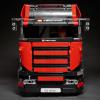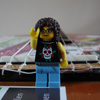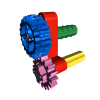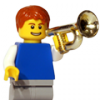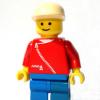Search the Community
Showing results for tags 'turntable'.
Found 17 results
-
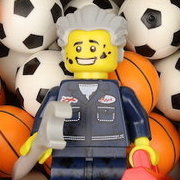
[GBC] Turntable Cup to Cup 2.0
Berthil posted a topic in LEGO Technic, Mindstorms, Model Team and Scale Modeling
Version 2 of my cup to cup GBC but actually third rebuild. I thought it already had a separate topic but apparently not, hope you don't mind I create this one. After running it at several events, where it was one of the favorites of the public, I updated the drive system to a more direct drive and better force distribution by driving the crank through a 36 teeth gear instead of directly on a single axle. Also added more steppers for better ball entry and exit with basket. Direct drive from the XL motor. According to the gear calculator from Sariel this setup has 46Nm compared to 16Nm for the previous one! This makes the whole GBC run smoother and more reliable resulting in no dropped balls during the half hour I tested. The turntables are mounted with neck brackets in the frame to get the correct gear distance. For reference, version 1 video here -

[MOC] Vinyl, Turntable and Phono
camellia posted a topic in LEGO Technic, Mindstorms, Model Team and Scale Modeling
Watch Footage With the resurgence of vinyl over the last several years, a whole new generation is getting into turntables. Turntable Cartridge Moving Magnet Moving Coil Moving Iron A look at vinyl record grooves at around 1000x magnification. You can see the waveforms of the music itself… Vinyl Diameter:12”;10”;7”. Rotational Speed:8-1/3 rpm;16-2/3 rpm;33-1/3 rpm;45 rpm;78 rpm. Time Capacity:LP[Long Playing] with 12” and 33-1/3 rpm;SP [Single Play] with 10” and 78 rpm or 7” and 45rpm;EP [Extended Play] with 12” and 33-1/3rpm or 7” and 45rpm. Reproductive Quality or Level of Fidelity:high-fidelity;orthophonic;full-range. The number of Audio Channels:Mono;Stereo;Quad. Internet of Things Controller Music, after all, is something that brings joy to our lives. Vinyl gives us a way to increase the joy factor and explore music in new and exciting ways. That joy is the essence of the vinyl revival. It’s why people are gleefully purchasing records again. www.camellia.xin www.camelliacafe.cn Copyright © Camellia Café 2016-2021 Camellia Café and its LOGO are registered trademarks. Please kindly visit Camellia Café -
Hello everyone: I am glad to share this project, the mining excavator, based on Cat 6090. Phisycal Configuration: The Lego Cat6090 is a motorized digger on tracked wheels, 2 XL motors provided enough torque. On the track frame is placed the main structure, and a heavy duty turntable allows good rotations, without fricctions. The turntable is rotated by means of 1 XL motor. The main structure contains: the XL motor for turntable, the air compressor, 4 servos for pneumatic valves and the controller. The design is ultra compact in order to meet the requierement of size/scale. The tracked whell is ultra rigid structure, designed to resist extreme load. The air compressor has 4 XL motor and 2 pneumatic pumps, in order to provide a constant air flow and high pressure, both pumps are de-phased 180° in order to reduce vibrations. 4 PF-servos open/close 2 way air valves, to command all pneumatic actuators. The boom has 2 large pneumatic actuator. Due to heavy height of the boom, 4 spring supply extra force during the elevation. 2 large pneumatics actuators push/pull the arm, those actuators are placed below the arm. 2 large penumatics actuators dedicate to rotate the bucket. 1 medium pneumatic actuator, open/close the bucket. Electrical configuration: Three 18650 batteries provide an average of 11.1 V, the compressor are suplied with 11.1 V, and the servos, lights and turntable motor are suplied with 9V. A BMS (Battery Managment System) manages the charge and the discharge durgin the operation. The tracked frame is steering by the use of 11.1 V, and as well is manage by the use of a BMS. On Board System (OBS): The name given to the controller. There are two systems, one for the main structure, and the secund is used to move the tracked well. The main controller, is a server TCP/IP protocol. The controller has a ESP8266 microcontroller with a TCP/IP stack, this controller is able to be programmed in arduino languaje (also micropython) - Teh ESP8266 is used as a sever, Motor driver: used to control the compressor The 4 PF servos are controlled by means of digital outputs, and the lights. ld293d, this is a H-bridge used to control the turntable motor. The second controller, is a ESP8266 as a client, and controls the speed of the tracks. Also, it has a BMS in order to regulates the charges/discharge of the batteries Accessories: 1) Josyticks: Two joysticks, with 4 dof (degrees of freedom) each of one plus a on/off button, are connected to the server module. 2) App: An application developmented under Android studio is used to visualizate the air pressure and electrical current, this app is WIP (work in progress). Conectivity: The comunication used is socket TCP/IP- Main features: maximun pressure reached: 52 psi (358 Kpa) Voltage bus: 11.1 V Compressor electrical consuption: 23 W Weight: 6 kg Length: 30 cm width: 20 cm height: 30 cm Here some pictures, during the construction and commissioning Note: my apologies for my primitive english
-
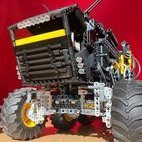
[MOC] Christmas Tree (of Doom)
teetertater posted a topic in LEGO Technic, Mindstorms, Model Team and Scale Modeling
Hello, I got back into Lego during quarantine and decided to try something unique in the holiday theme. Here's my driving, spinning, Christmas tree. The top part is made with three turntables, with rotation driven by motors at the base. Frictionless pins and/or axles allow the "branches" to raise or lower with centripetal force. I know it's ugly, but I was aiming for a freaky vibe so that worked out Here's a short demo, with some videos of the inner workings too: View from underneath: Side detail closeup More photos: https://www.flickr.com/photos/191824083@N05/with/50858767061/ Happy to hear your feedback and design tips. I lurked this forum for a while and learned many building tricks.- 6 replies
-
- turntable
- remote control
-
(and 3 more)
Tagged with:
-
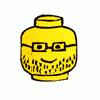
Motorised display turntable
MajklSpajkl posted a topic in LEGO Technic, Mindstorms, Model Team and Scale Modeling
I've built a "simple" motorised display turntable for one of our exhibitions and a good friend asked for instructions so I made a quick photo sequence and HERE there are for all of you who might find it interesting. It is based on the 42082 turntable and a keen eye will find it totaly unoptimised and too expensive :-) But here it is - and it is what it is. It handled the weight of OOB Chiron for a weekend with no problem. Best regards. -

Rotating Axle with Varial Offset
ancientpixel posted a topic in LEGO Technic, Mindstorms, Model Team and Scale Modeling
Hi All! Often a "reader", now a "poster", i´ve got a problem i cant fully wrap my head around. I try to keep a steering axle straight while going through a pivoting point or turntable. The axle should rotate with the pivot (eg in the picture below the yellow bricks should always align with the grey liftarms even if the liftarms are at 90 degrees of each other) but i want to rotate it manually on one side, with the rotation + offset of the pivot on the other side. Like the axle itself would have been twisted. The furthest ive got with this is pictured below and works as long there is no friction on the left output. I want both sides to rotate at the same time, but if you rotate the pivot/turntable then it should add just an offset "within" the axle. I dont know if this is actually possible or how to split the axle in two, add the pivot rotation to one part and then add both rotation together. -
This might be interesting for trainfans: link to CUUSOO: http://lego.cuusoo.c...deas/view/33485 Description in link. This is not made by me, i just show it to you.
-
Railroad locomotive XL turntable - 12 outlet tracks and modular control tower
Murdoch17 posted a topic in LEGO Train Tech
Here is my XL turntable, which has 11 dead-end stall tracks and one outlet track. (though it can be reconfigured to be as many or as few tracks as needed). It is spread out over a 64 x 64 XL make-shift base plate size made up of of 4 regular (32 x 32) curved road plates with quite a bit of overhang due to the outlet tracks and tower. The re-purposed signal tower is now being used to control the turn table. This control building is modular, and has a roof and second floor that come off to reveal inside details. The studs on the sides of the building are supposed to spell out the the yard's name, but I haven't decided on a good name yet. If you have any suggestions for a name with 10 letters or less, please post a comment with it below! This table can handle a 4-track long engine (around 64 studs) with a bit of overhang at the ends, such as with my Frisco 1522 4-8-2 steam locomotive as seen above. Diesel A + B unit sets would have to be separated and moved independently, but that's okay and actually accurate for some real world locations / railroads. The basic workhorse of the turntable is this four track long framework you see here. The table's modular control tower features a lower floor that's empty except for the staircase. The upper floor features a machine to control the turn table, a wall clock, and a old-fashioned rotary telephone. The table easily glides on an raised outer ring of tiles, and turns on a central 2 x 2 pivot point. This whole thing can be mechanized, much more easily than a transfer table, but it still needs fine tuning to make it work right. The outer ring of tracks is only attached to the base plates at two certain points: every other spot is held on by gravity. (plates on tiles) This is basically a very much enlarged version of this model here. I was working on a seven-stall shed in the same style as the tower to connect to the turntable, but the angles and hinge bricks weren't working out due in LDD. I guess it will have to wait until the turn table is built in real life.... if it is ever built in the real world. Comments, questions, suggestions, and complaints are always welcome, as usual and thanks for stopping by! -
I was inspired by a failed Ideas project railroad round house and shed from this builder to make this Wild West armstrong turn table in LDD. I'm thinking of doing this model instead of the the two track shed, as it is a bit smaller than the twice-as-tall shed. As this a mechanical table powered by brute force and not steam, electric, or pneumatic means, the table has four angled "iron" bars for mini-figures to grip to pretend-turn the table manually. (This type of table is called an armstrong turn table.) The two sets of tiles on the middle of the table should have this GREAT and this WEST prints from the Toy Story 3 line. NOTE: The flex tracks are supposed to be taken apart into two halves for them to fit on the table ends. You should only need one flex track instead of two as shown, as one whole equals two half units. The 3 and 1/2 track long table has eight tracks radiating outwards on it, with the possibility of more or less tracks if needed being an option in the future. If this was built in real life, the four main locomotives will enter on the bottom-most track and proceed to be rotated to the correct stub-end track for storage. However, the BTTF Time Train cannot fit on the rotating table, (it's just a bit too long) so it will sit on the straight-through track and just run across the table to get off at the other side. (All the items but the blue steam engine and table itself have been bought and built in real life.) As usual, comments, questions, suggestions, and complaints are always welcome!
-
Now I m going to research a XL turntable for my moc, now it can take over 10kg and moving smooth . Maybe i need to upgrade 15-20kg.
-

[HELP] Building a Truck
BuildSnapPost posted a topic in LEGO Technic, Mindstorms, Model Team and Scale Modeling
Please Help me! I am making a LEGO truck, and I was wondering whether it is possible to build a vehicle with two suspensions like this. : 1. https://www.youtube.com/watch?v=b_bN7rFMjaw 2. http://sariel.pl/2010/11/steered-suspension-for-heavy-trucks/ Firstly, would it work if I have two of these style of suspensions and; Secondly, would it work if i have them without shock absorbers to return the wheels level in reference to the vehicle. Thanks, BuildSnapPost. -
It has been a while… Some of you know me from my previous layout. This layout has been taken apart and the new version is now under construction. I made my plans for this new layout early March. Planning by UrbanErwin(EPJL), on Flickr A big thank you to scruffulous for the BlueBrick files he sent me once. I had a small list of things I really wanted to have in my layout: - long or large curves as described by Railbricks and Cale Leiphart. - a turntable, better looking and functioning than my previous design - it has to be modular for easy transport - it has to connect properly to the other layout builders at LowLUG. I first laid the basplate and added track to see if my idea actually fitted, it did! Next where some tiles to mark the edge of the areas which should be tiled to support the track: Then the fun really began, building actual modules: Layout V5.0 work in progress 8-4-15 by UrbanErwin(EPJL), on Flickr Layout V5.0 work in progress 9-4-15 by UrbanErwin(EPJL), on Flickr Work in Progress update 13-04-2015 by UrbanErwin(EPJL), on Flickr After a couple of days building I made a start with the turntable: Some more foundations and landscaping Update 20-04-2015 by UrbanErwin(EPJL), on Flickr And this is the current state of progress: Work in Progress update 21-04-2015 by UrbanErwin(EPJL), on Flickr Work in Progress update 21-04-2015 by UrbanErwin(EPJL), on Flickr I will try to add updates every time I added something.
-
Only two axles through a Lego turntable (the 48452cx1) has always irritated the more experienced Technic builders, stimulating them to work out many different solutions. Actually, some really clever solutions have been found, but most of them cause too much friction or require too much space. I have succesfully tried to do an attempt too, thanks to 3D printing and a good friend, he designed the CAD model of my solution. I can say that my solution has low friction and consumes much less space in comparison to the existing solutions. More of the story and some more pictures can be found at http://mocpages.com/moc.php/419288 I have made an elaborate video about the problem and the process, but I think it will be 6 well-spent minutes. At the end of the video, there is another big surprise... Something that never was possible, is possible with the new parts! http://youtu.be/1OsSGkDsgXs To get a better idea of the part, you can find some photos here: All photo's can be found on: http://mocpages.com/moc.php/419288 in a higher resolution. The CAD drawing assembly: This design is extenable to bigger versions, I think that up to 5 or 6 axles would fit through the turntable. The only problem is connecting all gears in a robust way: to 'get to the gears', the outer gears have to get a bigger diameter and the problem of space-consumivity is back. I found that the three axle design really was a good optimization between robustness, way of accessing the gears and maximum transported torque through them. It is my hope that the Lego group takes over this idea and starts producing it, because especially the three-axle option ore the two-axles through the small turntable could be very useful in an upcoming Lego flagship. So, if you happen know someone at the Lego Technic department, please give him/her a good impression of the idea!
-
The last months I've been working on a new project. A turntable and a shed. The turntable is powered by a PF-M motor. All the PF is inside the turntable itself. Here are some images of the process, I'll post more images when I'm further in the process. Here is a video showing the first functional test of the turntable:
-
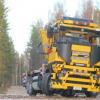
[TRIPLE] 7Ch IR Logging truck
Tech-nick posted a topic in LEGO Technic, Mindstorms, Model Team and Scale Modeling
Ok, here is my entry, got it finished this morning after all night build. My triple consist of truck, removable log crane and trailer. The truck and the crane work with remote PF. (except outriggers on crane are handled manually) The truck: The truck features forward/reverse (L-motor) and return to center steering by PF servo. In the truck are also located the cranes turntable and main boom motors (M&L). It uses maximum 500 parts, it was quite a challenge to do such large model with relativelly small part count. I used LDD trough all the build, so it shouldn't exceed the max part count. I learned a LOT on optimizing and utilizing special technic parts. I'm quite happy with appearance of it, and I like the cabin very much. All tho I had to tape few panels black cause I hadn't anough of them :( But I think you hardly notice :) The crane: The crane features main boom, second boom, and fully operational claw. They work remotely. (one channel not used) Motors are M. It has also manual outriggers. Crane also uses all 500 parts. The claw rotates using small turntable and claw closing action is fed trough it. The claw is synchronized so turning the claw won't affect much to closing action. The synchronization is done in the superstructure with system of gears and differential. In short, when the turning motor is driven, it also turns the the claw gears trough the stationary differential in opposite direction so the claw is almost unaffected (It was not possible to exactly match the gear ratios with small turntable). When claw motor is driven, is the differential turning and closing/opening the claw. Claw turning is not affected at all. I'm quite pleased with this brainchild. It could be used with any other application when turntable is causing undesired action. Below is the crane with out battery case, so the system is visible: (It's a poor picture, I don't know can you make any sense of it) The trailer: Nothing special there, other than it uses only 453 parts :) oh, and I'm also short of double angular beams in same color. All my Black and dark grey ones are in this triple. Finally, all working together: Short video clip: I think I will just copy this to entry topic. (Did it) Feel free to comment. -
As already hinted at the presentation of the turntable a larger project of railway infrastructure display was under way. So the typical engine depot from the era of steam traction was created. Unfortunately not a very common sight these days as most of these buildings were taken out of operation together with the demise of the steam engines they housed and left to decay, but many were also preserved as listed buildings or converted into museums. The depot has a turntable, engine shed and some smaller objects: masonry water tower, storage shed and a small crane. The turntable for the engines. Its basics were already presented here while this final version got some minor alterations - the pit wall is reinforced with an additional line of hinges and extended by 4 studs in circumference to allow smoother rotation of the bridge. And of course a control box is added. A shed for storing the workers' tools and a wide variety of junk. Water tower with liftable water pipe. A small crane is also located at the depot where the sleepers are being loaded onto a railcar. Disused stuff is lying all around. The old telegraph poles are dumped next to the storage shed. The largest building at the depot is the engine shed with room for four Emeralds. The interior of the engine shed. Three rails are intended for housing engines only. The rail at the right side of the engine shed has some more space around it and here the repairs and smaller maintenance works take place. The workers in the engine shed also throw all the rubbish right behind the wall where empty barrels and various disused engine parts keep accumulating. The entire thing is 160x96 studs (127x77 cms) in size and took about 70 hours to build. Some more pictures can be found here.
- 14 replies
-
- infrastructure
- train shed
-
(and 1 more)
Tagged with:
-
So, I said I would make one, so here it is: Overview: Lego Train Turntable: Main by UrbanErwin(EPJL), on Flickr Some details Lego Train Turntable: Details by UrbanErwin(EPJL), on Flickr Lego Train Turntable: Details by UrbanErwin(EPJL), on Flickr The control box: containing all the PF stuff Lego Train Turntable: Details by UrbanErwin(EPJL), on Flickr Lego Train Turntable: Details by UrbanErwin(EPJL), on Flickr Lego Train Turntable: Details by UrbanErwin(EPJL), on Flickr Powering is done by a Monorail motor. This will of course be placed in my new layout. I hope you liked it


